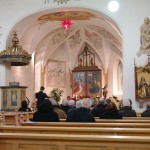Two Catholic laymen are credited with starting Labor Day: Matthew McGuire (1855-1917) and, no relation, Peter J. McGuire (1852-1906). Matthew McGuire was a machinist from Paterson, NJ who began factory work at age 14. Throughout the 1880s he was involved in the Knights of Labor, the first successful national union in this country.
Peter McGuire was born in New York City. He moved to St. Louis where he was a carpenter. In 1881 he moved to Chicago and formed the United Brotherhood of Carpenters out of 12 small unions. He eventually became the first secretary of the American Federation of Labor.
In 1882 the two men organized a Knights of Labor parade in New York City. It was repeated in 1883 and 1884. The 1884 parade was the first time the day was called Labor Day. Subsequently, the idea of an official Labor Day caught on in Oregon and then in a few other states. The first Saturday of June was the designated holiday. Soon enough the day was changed to the first Monday in September. Finally in 1894 the U.S. Congress voted to make that day a national holiday.
The relationship between organized labor and U.S. Catholicism has been mutually beneficial. Why not? Until recently, the constituencies were the same.
A key incident occurred in 1887 when Pope Leo XIII held a consistory to commission new cardinals. Among his picks was Archbishop James Gibbons (1834-1921) of Baltimore. A bishop in Quebec had just condemned the Knights of Labor, calling it a secret society akin to the Masons. Vatican officials supported the Canadian decree and were prepared to extend it universally. Gibbons used his opportunity in front of the pope to prevent any such thing from applying in the U.S. Of note: Four years after this consistory, Leo XIII issued the first modern social encyclical, On the Condition of Labor.
The relationship between U.S. Catholicism and organized labor is less prominent these days. Catholic institutions get their donations from suburbia and significantly less from urban immigrants, who were once the base for unions. Also, unions have fewer members than in the past, including fewer Catholics. The relationship is so ignored that here-and-there trustees of Catholic institutions violate our doctrine on labor relations with impunity.
How can U.S. Catholics observe Labor Day, September 7, 2020? First, treat it as a Sabbath. Specifically, don’t shop on Labor Day so that as many workers as possible have an easy day of it. Second, read about Catholic labor doctrine. Start with St. John Paul II’s beautiful meditations on work. (See below.) Third, participate in the liturgy despite the Covid-19 alterations. Praying a portion of the liturgy of the hours at home is recommended. It is equally safe to participate at the live stream Mass on www.catholiclabor.org at 1 PM Central, September 7th. (Prior registration is requested.)
A final word on liturgy. Back in the day I was part of a lobby group to change the feast of St. Joseph the Worker from May 1st to the first Monday in September—in the U.S. only. The proposal got a fair hearing from several bishops, but the liturgy police in Washington, DC squelched it.
The May 1st feast was instituted to counter the Communist celebration of May Day or Workers’ Day, which is still observed in some European countries. Ironically, the communists picked that day because of the 1886 Haymarket incident here in Chicago. A rally for an Eight Hour work day turned violent—seven police and four workers died. Eight workers were quickly arrested and seven were convicted. A few of us in Chicago honor this history but it is lost on almost all U.S. Catholics, including those who observe May 1st as the St. Joseph feast. The U.S. origin of May Day is also, I suspect, lost on those who observe the holiday in Europe.
Droel is the editor of John Paul II’s Gospel of Work (National Center for the Laity, PO Box 291102, Chicago, IL 60629; $8).










